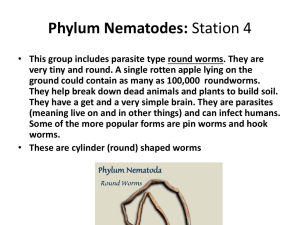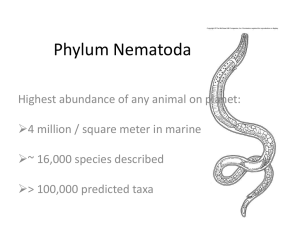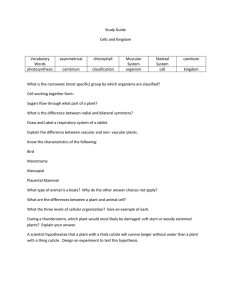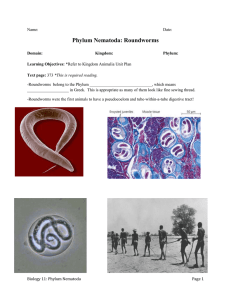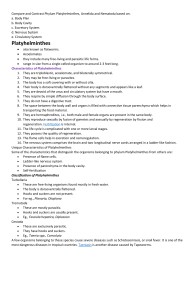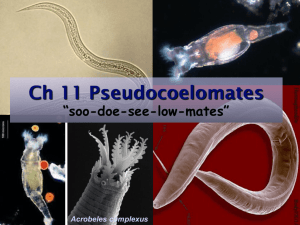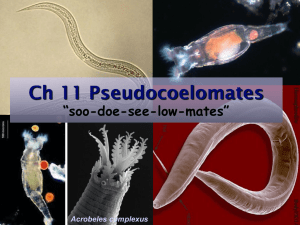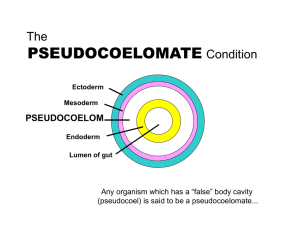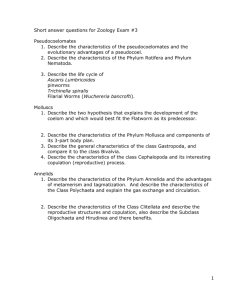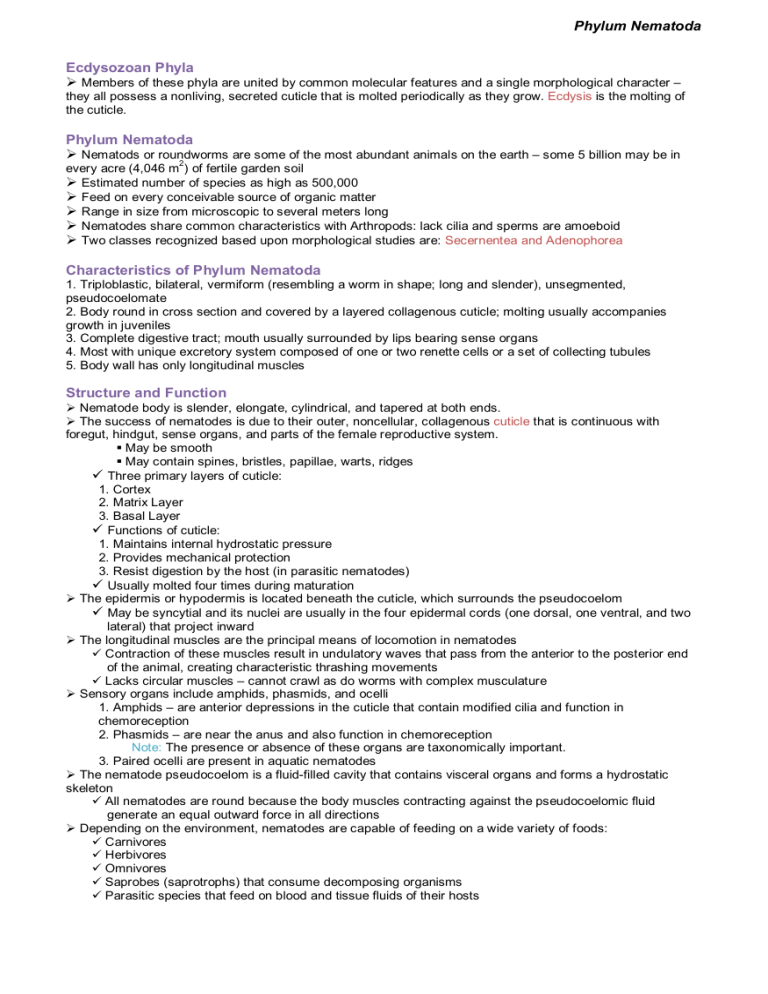
Phylum Nematoda Ecdysozoan Phyla Members of these phyla are united by common molecular features and a single morphological character – they all possess a nonliving, secreted cuticle that is molted periodically as they grow. Ecdysis is the molting of the cuticle. Phylum Nematoda Nematods or roundworms are some of the most abundant animals on the earth – some 5 billion may be in 2 every acre (4,046 m ) of fertile garden soil Estimated number of species as high as 500,000 Feed on every conceivable source of organic matter Range in size from microscopic to several meters long Nematodes share common characteristics with Arthropods: lack cilia and sperms are amoeboid Two classes recognized based upon morphological studies are: Secernentea and Adenophorea Characteristics of Phylum Nematoda 1. Triploblastic, bilateral, vermiform (resembling a worm in shape; long and slender), unsegmented, pseudocoelomate 2. Body round in cross section and covered by a layered collagenous cuticle; molting usually accompanies growth in juveniles 3. Complete digestive tract; mouth usually surrounded by lips bearing sense organs 4. Most with unique excretory system composed of one or two renette cells or a set of collecting tubules 5. Body wall has only longitudinal muscles Structure and Function Nematode body is slender, elongate, cylindrical, and tapered at both ends. The success of nematodes is due to their outer, noncellular, collagenous cuticle that is continuous with foregut, hindgut, sense organs, and parts of the female reproductive system. May be smooth May contain spines, bristles, papillae, warts, ridges Three primary layers of cuticle: 1. Cortex 2. Matrix Layer 3. Basal Layer Functions of cuticle: 1. Maintains internal hydrostatic pressure 2. Provides mechanical protection 3. Resist digestion by the host (in parasitic nematodes) Usually molted four times during maturation The epidermis or hypodermis is located beneath the cuticle, which surrounds the pseudocoelom May be syncytial and its nuclei are usually in the four epidermal cords (one dorsal, one ventral, and two lateral) that project inward The longitudinal muscles are the principal means of locomotion in nematodes Contraction of these muscles result in undulatory waves that pass from the anterior to the posterior end of the animal, creating characteristic thrashing movements Lacks circular muscles – cannot crawl as do worms with complex musculature Sensory organs include amphids, phasmids, and ocelli 1. Amphids – are anterior depressions in the cuticle that contain modified cilia and function in chemoreception 2. Phasmids – are near the anus and also function in chemoreception Note: The presence or absence of these organs are taxonomically important. 3. Paired ocelli are present in aquatic nematodes The nematode pseudocoelom is a fluid-filled cavity that contains visceral organs and forms a hydrostatic skeleton All nematodes are round because the body muscles contracting against the pseudocoelomic fluid generate an equal outward force in all directions Depending on the environment, nematodes are capable of feeding on a wide variety of foods: Carnivores Herbivores Omnivores Saprobes (saprotrophs) that consume decomposing organisms Parasitic species that feed on blood and tissue fluids of their hosts Phylum Nematoda Have a complete digestive system consisting of a mouth, which may have teeth, jaws, or stylets (sharp, pointed structures); buccal cavity; muscular pharynx; long, tubular intestine where digestion and absorption occur; short rectum; and anus. Hydrostatic pressure in the pseudocoelom and the pumping action of the pharynx push food through the alimentary canal Accomplish osmoregulation and excretion of nitrogenous waste products (ammonia and urea) with two unique systems Aquatic species: Glandular system consists of ventral gland cells called renettes, posterior to the pharynx Each gland absorbs wastes from the pseuodocoelom and empties them to the outside through an excretory pore Parasitic species: Tubular excretory system that develops from the renette system The renettes unite to form a large canal, which opens to the outside via an excretory pore The nervous system consists of an anterior neural ring Nerves extend anteriorly and posteriorly; many connect to each other via commissures Certain neuroendocrine secretions are involved in growth, molting, cuticle formation, and metamorphosis Reproduction and Development Most are dioecious and dimorphic, with the males smaller than females Long, coiled gonads lie free in the pseudocoelom The female system consists of a pair of convulted ovaries Each ovary is continuous with an oviduct whose proximal end is swollen to form a seminal receptacle Each oviduct becomes a tubular uterus; the two uteri unite to form a vagina that opens to the outside through a genital pore The male system consists of a single testis, which is continuous with a vas deferens that eventually expands into a seminal vesicle and ends at the cloaca The seminal vesicle connects to the cloaca Males are commonly armed with a posterior flap of tissue called a bursa, which aids the male in the transfer of sperm to the female genital pore during copulation After copulation, hydrostatic forces in the pseudocoelom move each fertilized to the gonopore (genital pore) The number of eggs varies with the species as some produce only several hundred, while others may produces hundreds of thousands daily Some give birth to larvae (ovoviviparity) External factors, such as temperature and moisture, influence the development and hatching of the eggs Hatching produces a larva (some parasitologists refer to it as a juvenile) that has most adult structures. The larva (juvenile) undergoes four molts, although in some species, the first one or two molts may occur before the eggs hatch Taxonomy of Phylum Nematoda Class Secernentea (Phasmida) Amphids ventrally coiled or derived therefrom; three esophageal glands; some with phasmids; both freeliving and parasitic forms Examples: Caenorhabditis Ascaris Enterobius Necator Wuchereria Class Adenophorea (Aphasmida) Amphids generally well-developed, pocketlike; five or more esophageal glands; phasmids absent; excretory system lacking lateral canals, formed of single, ventral, glandular cells, or entirely absent; mostly free-living, but includes some parasites Examples: Wuchereria Dioctophyme Trichinella Trichuris
